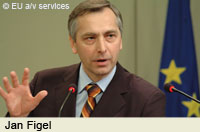More work needed to meet education targets
The European Commission has issued its 2006 report on the state of European education and training. The report states that Member States and the EU need to pull their socks up and put in more work and investment to meet the Lisbon agenda targets, set in 2000. The third annual 'Progress towards the Lisbon objectives in education and training' report based on indicators and benchmarks lists the progress made by 31 European countries, including EU Member States, in attaining five major educational benchmarks. The five targets are to be met by 2010 are: - the proportion 15-year-olds with poor reading literacy should decrease by at least 20 per cent compared to the year 2000; - At least 85 per cent of 22-year-olds in the EU should have completed upper secondary education; - The total number of graduates in mathematics, science and technology (MST) in the EU should increase by at least 15 per cent, and the gender imbalance should decrease; - Participation in lifelong learning should rise to at least 12.5 per cent of the adult (25-64 age group) working population; - Early school leavers should not number more than 10 per cent. The report concludes that to achieve these 2010 targets: two million fewer young people will have to leave school early; two million more will have to graduate from upper secondary education; the number of 15-years-olds underperforming in reading will need to be 200,000 lower; four million more adults will have to take part in lifelong learning. According to Ján Figel', European Commissioner for Education and Training, 'education and training are vital for achieving the goals set in 2000 by the European Council at Lisbon. Consequently, the Member States agreed to work towards common objectives for their education and training systems and that their progress would be monitored against a set of five benchmarks that are key pillars for improving education and training in Europe, It is clear that additional efforts are urgently needed to achieve the five benchmarks by 2010.' Most Member States have already made a difference in the uptake of MST, and this target seems the most likely to be achieved or even exceeded. EU-15 Member States Ireland, France and the UK are the best-performing nations, all with more than 20 graduates per 1,000 in MST. Estonia, Cyprus and Portugal have the highest proportions of women graduates in MST. The 2010 target calls for 1 million graduates per year, and the current level stands at 755,000. MST still needs to be pushed to ensure future European prosperity. The other benchmark targets seem far less likely to be achieved. In many cases, the newer Member States perform far better in primary and secondary education than the old EU-15. However, in lifelong learning, the old EU-15 nations generally perform the best. Reducing early school leavers to 10 per cent, and boosting to 85 per cent the number of upper secondary-level graduates, requires serious effort. These targets require schools to hold onto a total of four million extra students across the EU in the next four years. The nations with the lowest proportions of early school leavers are: Poland (at 5.5 per cent), Slovakia (5.8 per cent) and the Czech Republic (6.4 per cent). The countries with the highest proportion of upper-secondary level graduates are: Slovakia (at 91.5 per cent); Slovenia (90.6 per cent) and the Czech Republic (90.3 per cent). All the best performers in these two areas already exceed the 2010 targets, suggesting that the rest of Europe has an awesome and urgent task ahead of it. Today, 20 per cent (one in every five) of EU 15-year-olds are poor readers. The benchmark target aims to reduce this figure to 15.5 per cent (less than one in six), which would improve the literacy of some 200,000 students. Again, this target is a long way off. The most literate EU nations are: Finland (only 5.7 per cent, or less than one in 17 are poor readers); Ireland (11 per cent) and the Netherlands (11.5 per cent). One way to boost the performance of students would be to invest more in schools and education. In order to do this, the Lisbon agenda had a further set of targets: increase investment in tertiary education to match that of the US, and attract more than a million new teachers over the next ten years. Both targets need work. Tertiary education investment has increased to the level of the Lisbon target in the public sector, but the private sector has not increased its investment. This lack of private investment could also account for the relatively poor links between academic institutions and industry in Europe, in comparison with the US. In addition, all school leavers should be able to communicate in two foreign languages by 2010. In 2003, only between 1.3 and 1.6 foreign languages were taught in lower and upper secondary schools around Europe. Commissioner Figel' went on to say that, 'without better education and training systems, and wider participation in them, Europe's competitiveness cannot be improved. Investment in human capital is therefore clearly a vital investment in Europe's future.'



